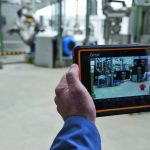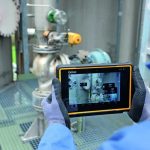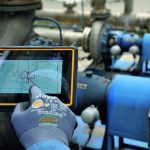For some time now, all the talk has been of “Industry 4.0”. This innovative glimmer of hope is now a beacon that also extends to “Maintenance 4.0”. Virtualisation and networking are key elements of Maintenance 4.0 as well as clear trends of the fourth industrial age. Feverish work is being carried out on new technologies that are intended to make everyday industrial life easier. Yet do these new Internet technologies really live up to expectations? Does tomorrow’s maintenance already exist today?
The pressure is mounting. No matter which way you look at it, everything has to be faster and more efficient, cost less and involve the least possible effort with no major barriers to investment. Production lines are increasingly complex and constantly being pushed to their limits. Disruptions have far-reaching consequences. Downtime due to failures – whether human or technical – cost money, time and reputation. Approaches to optimise maintenance and make it more economical are nothing new and regularly play an important role in strategic and operational plans for the future. Direct and indirect maintenance costs need to be minimised while maximising manufacturing reliability, employee safety, data security and machine output. The expectations placed in the technologies of the fourth industrial revolution are thus higher than ever, leading simultaneously to increasing uncertainty and resistance in the affected industries. No-one can say which measures will have which effects in practice because no long-term studies exist. Many people feel overwhelmed by new technologies: they are afraid of losing control and prefer to place their trust in simple paper. Should, or must, they be the first in line – and do they even want to be? Is the much-propagated Internet of Things really essential to be able to produce in a more cost-effective manner?
To predict what will go wrong
You don’t have to be a clairvoyant to know that the service life of a machine is finite. Predictive maintenance has long been a familiar concept for industrial companies in the western world. Maintenance 4.0 gives predictive maintenance a “helping hand”, as it were. More accurate predictions and more effective processes are the long-term goal. Real-time machine control data, condition monitoring data, historical data from the measuring room and a knowledge of previous disruption events are linked together to achieve optimal results and enable anticipative maintenance planning. This gives rise to several key advantages: precise predictions of plant breakdowns are possible, so that maintenance work can be undertaken at the right time and to the right degree. The machines operate more reliably as a result and more efficient use is made of resources.
Inspection round of the future
To illustrate this, let us now accompany a modern maintenance technician or operator on their inspection round of an industrial facility. In the past, they were confronted with numerous technical and functional problems. Security loopholes, insufficient information, data gaps and unwieldy planning materials or heavy tools such as notebooks were part of their everyday routine. Today, mobile devices are increasingly used to collect, check and audit technical information – and they also serve as a trusty companion.
Our technician is guided on the inspection round by a mobile device, similar in principle to a satnav system, and – courtesy of augmented reality (AR) – supplied only with significant data.
All he or she has to do is hold the tablet at eye-level facing the point of interest and look through the camera. Thanks to the integrated sensors, the device recognises the absolute position and height as well as the direction and angle of the target. The UBIK software then displays all data from the plant components concerned in the field of vision in real time. This information is already filtered in a qualified fashion before being extracted based on various user profiles, so that only data which is of relevance for the current inspection round and the logged-in user is actually visible.
To learn more about a specific pump, for example, it is sufficient to tap the basic data overlaid on the display. If required, the device also retrieves data from the linked consolidation server, which is in turn interconnected to all data resources throughout the company.
Depending on the content and quality of these sources, information such as additional pump specifications or datasheets, complex circuit diagrams, P&IDs or live values from the automation equipment can now also be retrieved. If everything is as it should be, the maintenance technician completes the inspection directly on the mobile device – while the consolidation server stores the captured data in the source system and immediately initiates all the necessary workflows. If any anomalies are noticed, they are documented directly on site and, if appropriate, forwarded to the competent person together with a photo or voice message. Important information is thus no longer lost but is automatically assigned to the originating point and employee.
However, at many companies, external staff who do not have the profound know-how of in-house personnel are responsible for the prompt detection and elimination of problems. They, too, can now be easily guided around the facility on secure paths with the aid of the UBIK AR navigation function. When our maintenance technician reaches the equipment, he or she needs to make sure they have in fact come to the right place. In addition to the usual identification technologies such as barcodes and RFIDs, UBIK can also recognise nameplates or tags and display information based on these labels. Industrial optical character recognition (OCR) technology thus turns existing labels into clearly identifiable markers. No additional labelling such as barcodes or RFIDs is necessary and no other data has to be collected: the software uses the same labelling for guidance and identification as a human being.
The advantages are obvious: the entire data for a designated item of equipment is available anywhere and at any time, and can be accessed quickly and easily. AR navigation puts an end to time-consuming searches for the equipment in need of inspection. Preparation and follow-up are substantially shorter and paperwork becomes obsolete. Individual work steps can be completed simply, safely and fast in line with the prescribed safety standards. Any maintenance activities are performed at exactly the right time and problems documented where they actually arise – including photos, videos and geographical information.
New technologies may indeed appear to be revolutionary. First and foremost, however, they must be seamlessly integrated into existing environments in order to gradually improve existing structures in a convincing manner and dispel all doubts. After all, revolutions need not only innovative technology but above all time.
www.cpp-net.com search: cpp0117augmensys
Jürgen Kneidinger
CEO,Augmensys
Share:









